Did you know over 9,000 people have looked into using garden soil for lawns? With 16 replies and 9 participants, this topic is really popular. But is garden soil a good choice for your lawn? Let’s explore expert advice to see the differences between garden and lawn soil. We’ll figure out the best way for a healthy lawn.
Key Takeaways
- Garden soil and lawn soil are different in composition and nutrients, each for a specific purpose.
- Using garden soil for lawns can cause compaction, poor drainage, and more weeds.
- Lawn-specific soil blends, like topsoil, are best for grass growth and health.
- Proper soil prep, including testing, amending, and aerating, is key for a lush lawn.
- Regular maintenance, like aerating and top-dressing, keeps soil right for your grass.
Understanding the Difference Between Garden Soil and Lawn Soil
Choosing between garden soil and lawn soil is key in gardening and lawn care. These soils differ in their makeup, nutrients, and properties. They meet the unique needs of plants and turfgrass.
Composition and Nutrient Content
Garden soil is packed with organic matter and nutrients, perfect for veggies, flowers, and ornamental plants. It often has compost, peat, or other additives to boost fertility and help plants grow. Lawn soil, on the other hand, is made to give turfgrass the right nutrients, drainage, and air for a healthy look.
Drainage and Aeration Properties
Garden soil holds moisture and nutrients well, while lawn soil is made for good drainage and air flow. Bad drainage or compaction in garden soil can cause problems like root rot, making it bad for lawns.
| Attribute | Garden Soil | Lawn Soil |
|---|---|---|
| Composition | Nutrient-rich, with added organic matter | Balanced for optimal turfgrass growth |
| Nutrient Content | Higher in nutrients and fertility | Tailored to support lawn grass |
| Drainage | Retains moisture well | Promotes better drainage and aeration |
| Ideal Use | Vegetable gardens, flower beds, containers | Lawns and turfgrass areas |
Knowing the differences between garden soil vs lawn soil is key. Look at their composition, nutrient content, drainage, and aeration properties. This helps pick the right soil for your gardening and landscaping.
The Risks of Using Garden Soil for Lawn
Garden soil might seem like an easy fix for low spots or starting a new lawn. But, there are big risks of using garden soil for lawn. One big issue is that it can be too dense, which stops water from draining well and air from reaching the roots. This can make it hard for grass to grow.
Also, garden soil might have problems with using garden soil for lawn. It could have weed seeds, pests, or diseases that hurt your lawn. The nutrients in garden soil might not be right for grass, leading to downsides of using garden soil for lawn.
- Garden soil may be too dense and compacted, hindering drainage and oxygen flow, which can inhibit grass growth.
- Garden soil can contain weed seeds, pests, or pathogens that can harm the lawn.
- The nutrient balance in garden soil may not be suitable for the specific needs of turfgrass.
“Soils with lead levels exceeding 100 ppm should not be used for gardening to avoid exposure to children through hand to mouth activity.”
Moreover, garden soil might have more contaminants like lead, which is bad for health, especially for kids. Studies show that background concentrations of lead in US agricultural soils average 10 parts per million (ppm), with a range of 7 to 20 ppm. High lead levels come from things like old paint and car emissions.
In conclusion, while garden soil might seem handy, the risks of using garden soil for lawn are bigger than the benefits. It’s important to check the soil’s make-up, how it drains, and its nutrient levels before using it for your lawn. This ensures your lawn stays healthy and looks great.
Preparing the Area for Lawn Soil
Starting with the right steps is key to a lush, healthy lawn. First, remove any old grass or plants. Then, make sure the ground is even and smooth. This careful preparation helps your lawn grow well and stay healthy over time.
Removing Existing Grass or Vegetation
Clearing the area of old grass or plants is a must before adding new soil. You can use shovels and rakes or a herbicide like glyphosate for this. Make sure to get rid of all the old growth for a fresh start.
Grading and Leveling the Ground
Once the area is clear, focus on making the ground even. Uneven ground can cause bad drainage and an ugly lawn. Fill in any low spots and aim for a slight slope for good water flow. Use a rake or leveling tool to make the ground smooth and ready for new soil.
By removing old plants and leveling the ground, you’re setting up your lawn for success. With the ground ready, you can pick the best lawn soil and plant your new grass or lay sod.
Choosing the Right Lawn Soil
Choosing the right soil is key to a thriving lawn. Topsoil for lawns and lawn starter soil mixes are great options. They are made just for turfgrass, not regular garden soil.
Topsoil for Lawns
Topsoil is the top 5-10 inches of soil. It has the right nutrients and drains well. Screened topsoil comes from different places, making sure it’s always top quality for lawns.
Lawn Starter Soil Mixes
Lawn starter mixes help new turfgrass grow strong. They mix soil, compost, and other helpers for the best lawn start. This mix is rich in nutrients and drains well, giving your grass a great start.
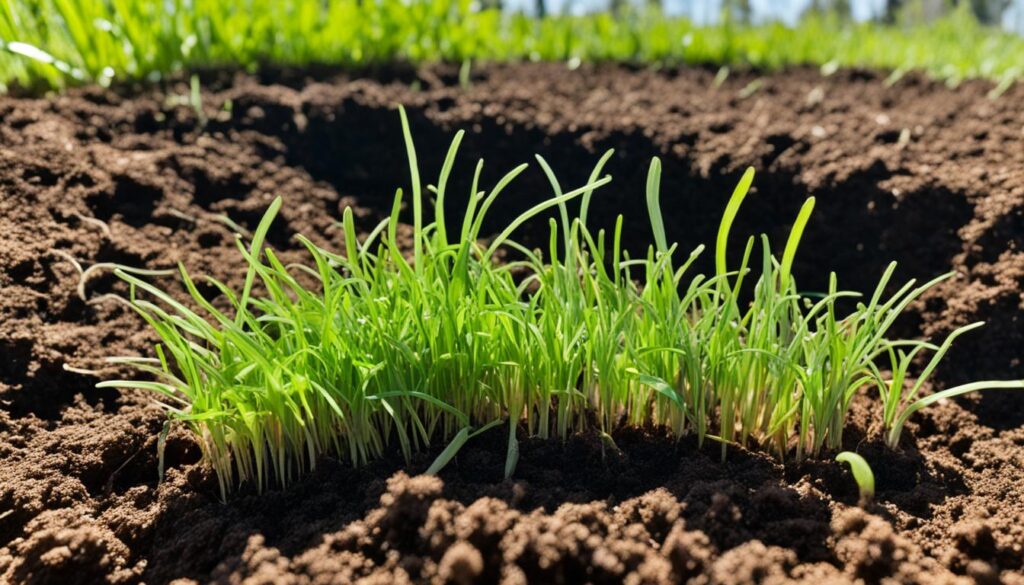
“Topsoil and lawn starter soil mixes are designed to deliver the optimal growing conditions for a thriving lawn, unlike garden soil which may be too dense or nutrient-rich.”
Choosing the right soil, whether topsoil or lawn starter mix, sets your lawn up for success. This step is key for a beautiful, lasting lawn.
can you use garden soil for lawn
Garden soil might seem like a good choice for filling in low spots or starting a new lawn. But, it comes with risks. Garden soil can be too heavy, causing poor drainage and not enough oxygen for grass. It might also have weed seeds, pests, or diseases that can hurt your lawn. Plus, its nutrients might not be right for the grass you want to grow.
Topsoil, the top layer of soil, is full of organic matter and nutrients that grass needs to thrive. Getting the soil ready right is key for a green, healthy lawn. Let’s look at the main differences between garden and lawn soil. We’ll see why garden soil isn’t the best choice for your lawn.
Composition and Nutrient Content
Garden soil is made for certain plants like veggies or flowers, not grass. It often has more nutrients or organic stuff than grass needs. Lawn soil is made just for grass. It has the right nutrients and pH levels for grass to grow well.
Drainage and Aeration Properties
Garden soil can be heavy and hard to drain, which slows down water and air in the lawn. Topsoil is lighter and lets air in better, which helps water get in and oxygen move around. This is key for strong roots and a healthy lawn.
“According to a study by ResearchGate, using garden soil for grass can result in stunted growth and poor overall lawn health.”
For a great lawn, it’s best to use topsoil or a special lawn mix. These are made just for grass. Knowing the differences between garden and lawn soil helps you pick the best for your lawn’s health and look.
| Garden Soil | Lawn Soil |
|---|---|
| Tailored for specific plants like vegetables or flowers | Formulated for the unique needs of turfgrass |
| May contain higher levels of nutrients or organic matter | Balanced nutrient profile and appropriate pH levels |
| Denser and more compacted texture | Lighter texture and improved aeration |
| Can impede drainage and airflow | Allows for better water infiltration and oxygen circulation |
Amending Existing Soil for Lawns
If your lawn’s soil isn’t perfect, you can fix it. Adding compost or peat moss boosts the soil’s organic matter, water retention, and nutrients. Sand or gypsum can improve drainage and air in the soil. Mix these into the soil to help your grass grow better.
Adding Compost or Peat Moss
Compost is great for lawns. It increases the soil’s ability to hold water and nutrients. Peat moss keeps moisture in and helps with acidity, which many grasses like.
Incorporating Sand or Gypsum
For heavy, clay-like soil, sand helps with drainage and air. This stops waterlogging and helps roots grow strong. Gypsum changes the soil’s structure without affecting pH too much.
Using the right mix of organic and inorganic materials can make your lawn soil better. This leads to a healthier, greener lawn.
| Soil Amendment | Purpose | Recommended Application Rate |
|---|---|---|
| Compost | Improves organic matter, water-holding capacity, and nutrient availability | 1-2 inches tilled or raked into the top 4-6 inches of soil |
| Peat Moss | Enhances soil acidity and moisture retention | 1-2 inches tilled or raked into the top 4-6 inches of soil |
| Sand | Improves drainage and aeration in heavy, clay-like soils | 1-2 inches tilled or raked into the top 4-6 inches of soil |
| Gypsum | Modifies soil structure without significantly impacting pH | 10-20 lbs per 1,000 square feet, tilled or raked into the soil |
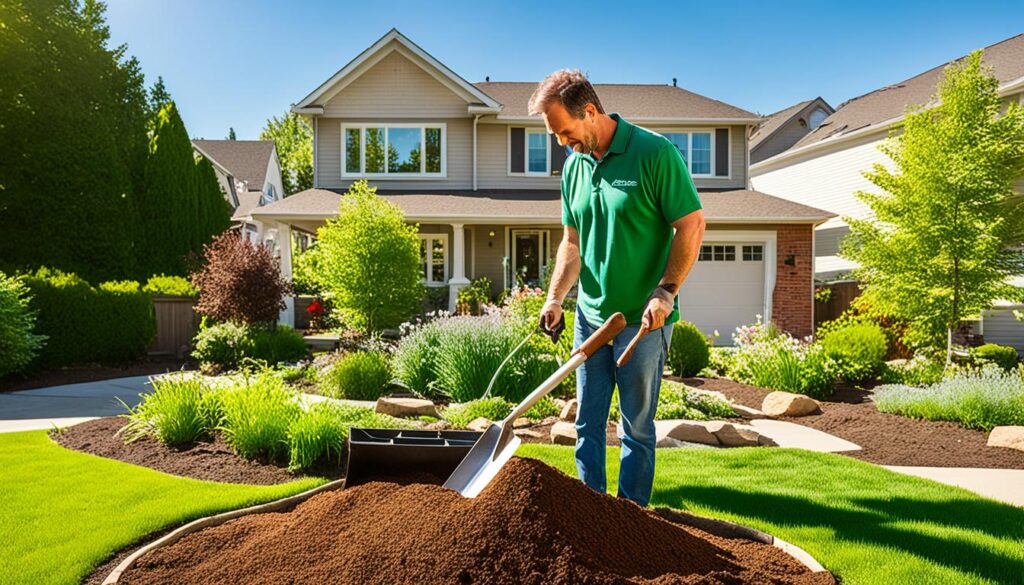
“Proper soil preparation is the foundation for a thriving lawn. By amending the existing soil, you can create the ideal growing conditions for your grass to thrive.”
Proper Soil Preparation Techniques
Getting your lawn soil ready is key to a lush, healthy lawn. You often need to till or rake the soil to loosen and aerate it. This makes it better for water to get in and roots to grow. Tilling mixes in any needed nutrients, and raking gets rid of debris and makes the ground smooth for seeding or sodding.
Tilling the Soil
Tilling is a common way to prepare the lawn area. It breaks up hard soil, adds organic matter, and makes a good seedbed for new grass. But, too much tilling can hurt the soil by damaging its structure and upsetting the balance of tiny organisms. The author recommends using deep tilling only for very hard areas. For general lawn prep, use gentle methods like shallow raking.
Raking the Soil
Raking is also key in preparing lawn soil. It uses a garden rake to clear out sticks, rocks, or dead plants. Raking also makes the soil level, which is good for seeding or sodding. By getting rid of obstacles and making the ground even, raking helps the lawn look better and work better.
| Soil Preparation Activity | Benefits |
|---|---|
| Tilling |
|
| Raking |
|
Using tilling and raking together helps prepare your lawn soil well for new grass or a lawn fix. Just remember not to overdo it with tilling, as it can harm the soil’s health and structure.
Seeding or Sodding the Lawn Area
When starting a new lawn, you can choose between seeding or sodding. Each method has its own benefits and things to consider.
Seeding means spreading grass seed over the soil and keeping it moist for growth. It’s cheaper than sodding but takes longer for the lawn to grow. It can take up to 10 to 12 weeks before you can walk on it lightly. A seeded lawn needs a whole year to be strong enough for heavy use.
Sodding lays down pre-grown grass sod on the soil for quick coverage. Sod costs more than seeding but roots well in two to three weeks. It’s great for slopes or areas that wash away easily, preventing erosion.
Choosing between seeding and sodding depends on your time, money, and what you prefer. Seeding is cheaper but takes longer. Sodding gives you a lawn faster but costs more. Both methods need good soil preparation for success in seeding new lawn and sodding new lawn.
“For shady spots, use seed mixes with fescues and shade-tolerant Kentucky bluegrasses. For sunny areas with lots of foot traffic, choose mixes with improved Kentucky bluegrasses, perennial ryegrasses, or tall fescues.”
Knowing the good and bad of seeding and sodding helps you pick the best option for your lawn.
Ongoing Lawn Maintenance and Soil Care
Keeping a healthy lawn means paying attention to the soil. Regular aeration helps by making holes for air and water to flow better. Top-dressing, or adding a thin layer of soil or compost, fills in low spots and improves the soil.
Aerating and Top-Dressing
Aeration is key for lawn maintenance. It helps with nutrient absorption, water flow, and root growth. You can use a handheld or walk-behind aerator for your lawn size. Top-dressing spreads a thin layer of compost or topsoil to level out the lawn and enrich the soil.
Fertilizing and Overseeding
Fertilizing your lawn regularly gives it the nutrients it needs. Overseeding fills in bare spots and thickens the grass. Lawn fertilization and overseeding are key for a lush, green lawn.
“Healthy soil is the foundation for a thriving lawn. By taking care of the soil through aeration, top-dressing, fertilization, and overseeding, you can ensure your lawn remains lush and vibrant for years to come.”
Keeping a healthy lawn takes time and effort. By focusing on soil care, you’ll have a beautiful lawn that boosts your outdoor space’s look and fun.
Troubleshooting Common Lawn Problems
Keeping your lawn healthy can be tough, especially with issues like bare spots and weeds. But, with the right steps, you can fix these problems and keep your lawn looking great.
Weeds like crabgrass and dandelions are common. Research from Iowa State University shows that corn gluten meal can kill up to 60% of weeds in the first year. Using a slow-release fertilizer with less than 3 lbs. of nitrogen per 1,000 sq. ft. a year can also stop crabgrass.
Thin spots in your lawn are another issue. Reseeding in the fall with perennial rye grass can fill these areas. It also fights crabgrass and some insects. Making sure the soil is healthy with aeration and compost can help your lawn and prevent weeds.
| Common Lawn Problems | Possible Causes | Recommended Solutions |
|---|---|---|
| Crabgrass | Warm soil temperature (52°F+), compacted soil | Pre-emergent herbicide, corn gluten meal |
| Dandelions | Perennial weed with deep roots | Remove entire plant, fall-applied broadleaf herbicide |
| Yellow Nutsedge | Compacted, moist soil, shallow roots | Selective herbicide, long-term eradication |
| Lawn Moss | Poor drainage, shade, compacted soil | Aeration, lime application, improved drainage |
| Thatch Buildup | Excessive organic matter, poor air and water flow | Dethatching, core aeration |
By keeping an eye on your lawn and fixing problems early, you can have a healthy lawn. It will be strong against weeds, pests, and other issues. With the right care and techniques, your lawn will look great and improve your property’s look.
Conclusion
Garden soil might seem like a good choice for lawns, but it’s not the best option. It lacks the right mix of nutrients and drainage for lawns. To get a healthy lawn, you need to prepare the soil well.
This means removing plants, leveling the ground, and adding the right kind of topsoil or lawn starter mix. This is key for a lawn that thrives.
Keeping up with lawn care is also important. This includes activities like aeration, adding nutrients, fertilizing, and planting new grass. By doing these things, you keep your lawn looking great. It’s all about picking the right soil and caring for it well.
This article highlights the importance of choosing the right soil and preparing it right. It also talks about the need for a good lawn care plan. By following these tips, you can have a beautiful lawn that makes your property look better.
In summary, this topic reminds us of the steps we need to take for a successful lawn. By using the advice given, you can prevent mistakes and have a lawn that looks amazing. It’s all about making the right choices and taking good care of your lawn.
FAQ
Can you use garden soil for lawn?
Garden soil might seem like an easy fix for lawns, but it’s not the best choice. It lacks the right mix of drainage and nutrients that lawn soil has.
What are the key differences between garden soil and lawn soil?
Garden soil is full of organic matter and nutrients for plants. Lawn soil, on the other hand, is made for the specific needs of grass. It ensures good drainage and the right nutrients for healthy growth.
What are the risks of using garden soil for lawns?
Using garden soil can lead to poor drainage and harm the grass. It might also bring weeds, pests, or diseases. The nutrients in garden soil aren’t always right for grass.
How should I prepare the lawn area before introducing new soil?
Start by clearing the area of any grass or plants. You can do this by hand or with a herbicide. Make sure the ground is even and filled in where needed for good drainage.
What type of soil is best for lawns?
Topsoil and lawn starter mixes work well for lawns. Topsoil has the right nutrients and drainage. Lawn starter mixes help grass grow and spread.
Can I amend existing soil to improve it for my lawn?
Yes, you can make your lawn’s soil better. Add compost or peat moss for more organic matter and better water retention. Sand or gypsum can help with drainage and air flow.
What are the proper soil preparation techniques for establishing a new lawn?
Getting the soil ready is key for a healthy lawn. Till or rake the soil to loosen it. This helps water and roots grow better.
Should I seed or sod my new lawn?
Choosing between seeding and sodding depends on your needs and preferences. Seeding spreads grass seeds over the soil. Sod lays down mature grass on the soil.
How do I maintain a healthy lawn over time?
Keeping a lawn healthy means regular care. Aerate, top-dress, fertilize, and overseed as needed. Fix bare spots, weeds, or discoloration quickly.
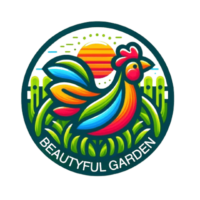
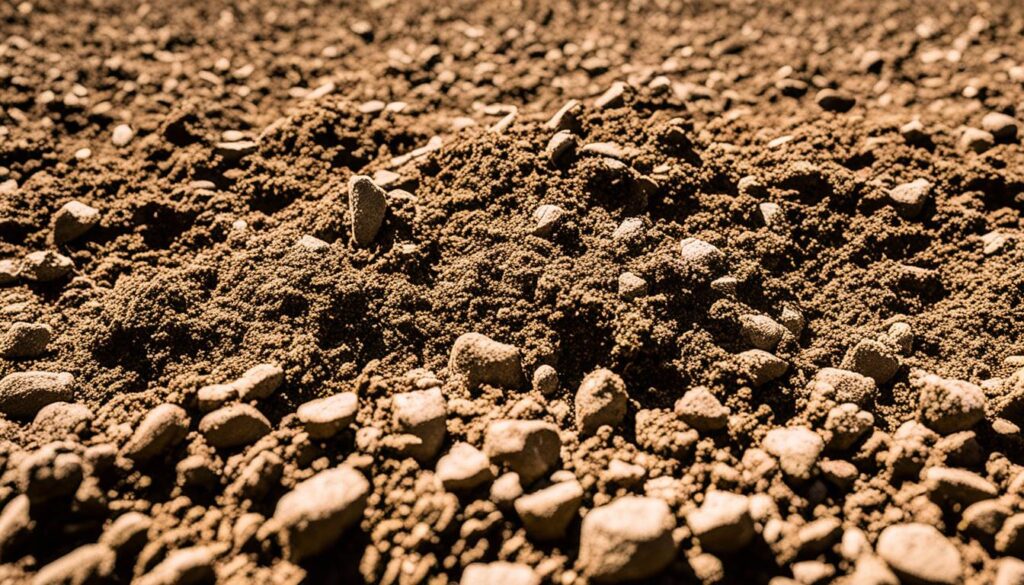
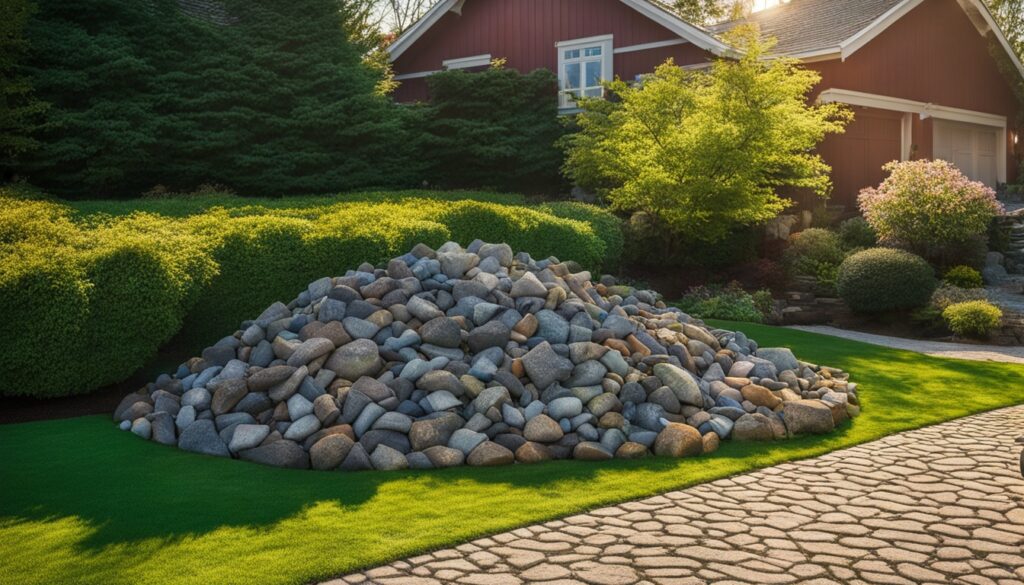
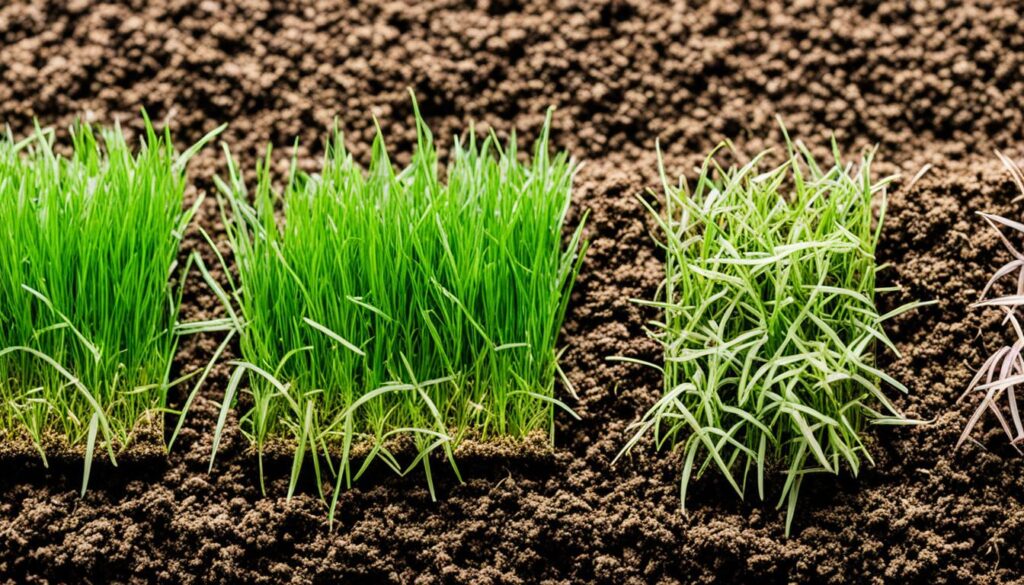
Thanks for sharing. I read many of your blog posts, cool, your blog is very good.